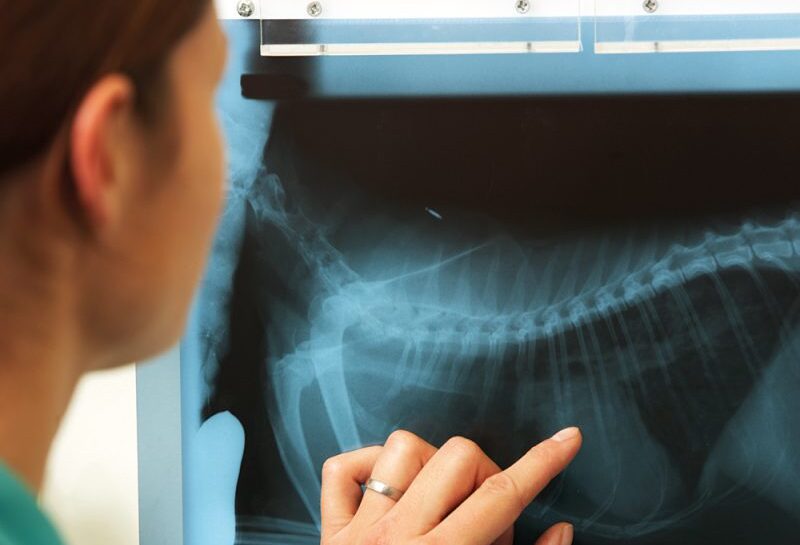Adaptix has developed a solution to the combined shortcomings of existing technologies: a novel X-ray source that allows low-cost, truly portable 3D scans.
Adaptix is developing an innovative new technology which could revolutionise medical imaging. 3D imaging for disease or trauma often relies on expensive CT scans, which deliver large radiation doses. Cheaper X-ray techniques only produce 2D scans.
The innovation is a flat panel X-ray source. It takes multiple low-dose X-rays and uses algorithms to turn data from the many ray paths into a 3D image, a technique known as ‘Digital Tomosynthesis’ (DT). This provides better clinical insight than 2D imaging, but using a fraction of the radiation of CT scans.
Challenge
A novel aspect of the panel is the grid of cold cathode field emitters – an array of tips which each generate a controlled X-ray. Many emitters can be packed onto a single panel allowing multiple simultaneous X-rays.
This is the first time a two- dimensional array of cold cathodes has been used for medical X-rays; other devices use bulky X-ray tubes. Adaptix compares this advance to moving from cathode ray tube TVs to flat screens.
The X-ray emissions need to be highly uniform in order to build a reliable 3D image. The emitters also need to meet durability requirements mandated for clinical use. Investigation revealed inconsistencies in the emitter tips, compromising both of these requirements.
Solution
Adaptix worked with the National Physical Laboratory (NPL) through the Innovate UK Analysis for Innovators programme, to understand how it could improve the materials of its cold cathode field emitters, and thereby improve performance.
Adaptix developed new materials and coatings which it hoped would improve the product and sent these to NPL to test and validate. NPL applied a wide range of state-of-the-art analysis tools to examine the structural and chemical properties of the material samples, including high resolution scanning electron microscopy (SEM) for structural analysis, and X-ray photoelectron spectroscopy (XPS) and secondary ion mass spectrometry (SIMS) for chemical analysis. Measurements were taken of the geometry of tips, quality of coatings, contaminants and oxidation state.
Research revealed differences between tip geometries and coating quality which potentially affected X-ray emission uniformity, identified surface chemistry contamination caused by manufacturing processes and highlighted the impact of high current on material degradation.
Through this research, Adaptix were able to improve uniformity by identifying optimal materials and coatings. It also helped them remove sources of contamination which they were not aware of – an issue that may have become a serious problem down the line. Additionally, measurements of how materials responded to different vacuum conditions allowed Adaptix to implement control mechanisms to limit failure, such as identifying the optimum vacuum levels. All of which improves the performance of the product.
We expect to have prototypes in manufacture by the end of 2018, and from there we hope to move first into dentistry and then into the clinical applications, capturing a share of the $12bn X-ray imaging market. The work with NPL will dramatically reduce the time it takes us to get to that point.
– Aquila Mavalankar, Principal Scientist at Adaptix Imaging
Impact
The work with NPL helped Adaptix understand their device and its failure mechanisms better, helping them make informed choices about design, material selection, surface chemistry and operating conditions.
It also helped them identify approaches that wouldn’t work and abandon them early, as well as identifying errors and contamination sources, freeing up time to focus on work that would deliver results. This improved the efficiency of their R&D and will reduce their time to market.
The great thing about NPL is they have lots of tools under one roof, so they form a team to come at a problem in multiple different ways. You end up really understanding the issue. This is of course helped by access to NPL’s state-of-art analytical technology, which is not found everywhere. We have also begun another project looking at modelling, and have discussed X-ray emissions testing in future. The breadth of expertise is really valuable, allowing multiple areas to be examined by a single organisation in a joined up way.
– Aquila Mavalankar, Principal Scientist at Adaptix Imaging
Further developments
Adaptix has since worked with NPL to increase consistency in the production of a key element of their product.
Watch the video case study to find out how the Innovate UK Analysis for Innovators programme made a difference for them.


